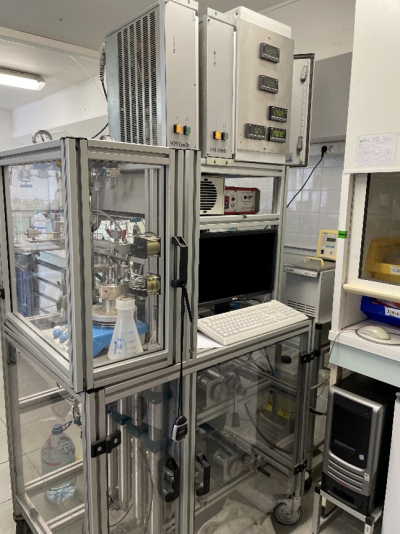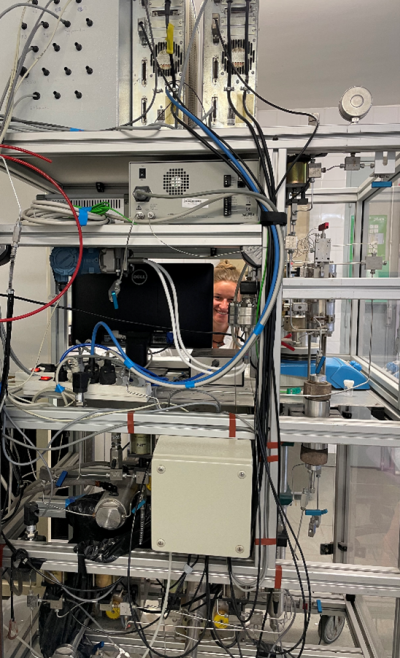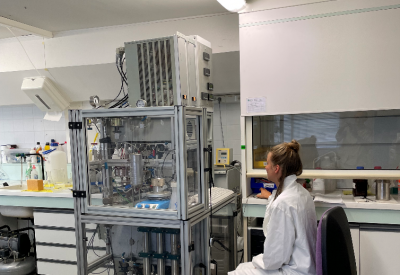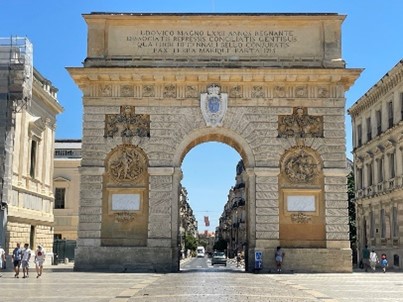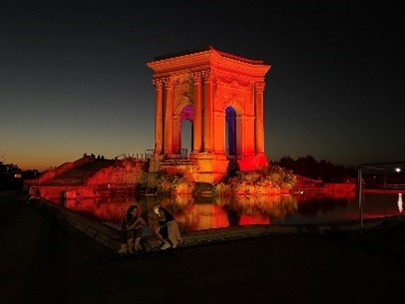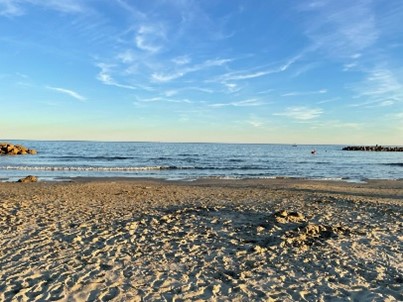- Graduate School GLOMAR
- PhD student reports
- Research Placements
- Isabel Lange
Isabel Lange
Report of GLOMAR Ph.D. student Isabel Lange about her research placement at the University of Montpellier in the ICARE laboratory from 15 June to 14 July 2023 and 4 to 29 September 2023
In my PhD project, I investigate basalt-seawater-CO2 interactions in the context of carbon storage in the basaltic ocean crust. Amongst other, I perform flow-through experiments simulating a CO2-injection scenario under conditions relevant to offshore storage. The experimental set up I designed is able to pump water and liquid CO2 simultaneously under pressures up to 100 bar and temperatures up to 100°C. Since these kinds of experiments are quite challenging, I expressed the wish for a research placement to learn from experts in the field and improve my experimental skills. Dr. Marguerite Godard, who is an expert in the field of mineral-CO2-water interactions and a member of my thesis committee, offered me to visit the ICARE Laboratory at the University of Montpellier, and even to perform high-pressure flow-through experiments in their lab supervised by Dr. Philippe Gouze. The ICARE lab is one of the ECCSEL - ERIC (European Carbon Dioxide Capture and Storage Laboratory Infrastructure – European Research Infrastructure Consortium) laboratories. The ICARE benches are technologically highly innovative and belong to the world leading flow-through systems to reproduce conditions of geological CO2 storage. The system can be operated up to temperatures of 300°C and pressures of 300 bar. Analytical capabilities comprise porosity, air and water permeability measurements, gas analysis by chromatography, Raman spectrometry, and complementary X-ray micro-computed tomography.
Mid of June 2023, I travelled to Montpellier by train, which takes approximately 12-14 hours, so I was very happy when I arrived at my room in a shared flat close to the old town. The next day, Dr. Godard and Dr. Gouze warmly welcomed me at the University, introduced me to many people from the group and gave me a tour through the laboratories. After I was supplied with all necessary keys and cards, and finished all the paper work, we were ready to start the work in the lab. Dr. Gouze and Richard Leprovost, the engineer of the lab, showed me all the ICARE benches and explained me how the systems run. The experimental set ups are really impressive.
In the following days and weeks we were discussing the experimental conditions and prepared everything for the experiments. This was a very inspiring process since there are so many details one has to keep in mind when designing, planning and performing high-pressure flow-through experiments involving fluid mixtures with supercritical CO2. Also, most of the equipment of the laboratory was designed by Richard Leprovost and Dr. Gouze to meet the specific requirements. This gave me the opportunity to learn a lot on a technical level and discuss all my questions with an engineer. The work in the lab I was doing included: Preparation of a compacted reaction core. For this, the sieved basalt granulates were filled into a stainless steel capsule using specific equipment to compress the granulates by applying 500kg on the cross section. Furthermore, we had to calculate many things, such as the composition of the artificial seawater, the partial pressure of CO2 in the water, the respective flow-rates of CO2 and H2O, the in situ pH conditions, etc. Since we wanted to conduct experiments with both a water-rich and CO2-rich fluid, we also had to modify one system a little bit and test if everything is working and whether there are any micro-leaks in the flow-line. Furthermore, I learned how to measure and calculate air and water permeability and air porosity of the samples. Finally, we were ready to start the experiments which, from then on, ran automatically most of the time. As the University of Montpellier is closed in Summer, I had to leave end of July and come back to Montpellier in September. I was very excited to go back for another three weeks. During that time, we stopped the experiments and prepared all the fluid and rock samples for analyses. After recovering the rock samples, they had to be dried and porosity and permeability had to be measured again. All these procedures have to be conducted carefully to not alter the samples after terminating the experiments. Afterwards, we filled the samples with epoxy so that thin sections could be prepared.
Despite all the exciting activities in the lab, I really enjoyed the working environment and the many conversations I had with Dr. Gouze and Richard Leprovost. We spent quite some time together in the office and during the lunch breaks discussing science. They were keen to listen to all my questions and concerns, and they gave me a lot of valuable input.
I was also invited to group activities and events of the Geoscience department where I got to know other PhDs and scientists in the field. Everyone was so hospitable.
In my spare time, I was discovering Montpellier, which is a very beautiful city with many cozy places and a lot of good food. The beach is also close by, so I sometimes went there to have a swim and watch the sunset after work. I was also happy that my French notably improved during my stay - after I learned it in school for many years but haven’t really used it since then.
To conclude, I am very grateful that I got the opportunity to do a research placement in Montpellier, both from a scientific and a personal perspective. My PhD project and my scientific skills strongly profit from this experience and the experiments we conducted. The research placement set the basis for my collaboration with the scientists in Montpellier, which we will continue. I want to express my gratitude to everyone involved: Dr. Godard, Dr. Gouze, and Richard Leprovost for inviting me, for the support and the fruitful cooperation; the other members of the working group in Montpellier for welcoming me so warmly; my supervisor Professor Bach and GLOMAR for giving me the opportunity and financial support which made it possible for me to do the research placement. It was a great experience that I will live on for a long time.



